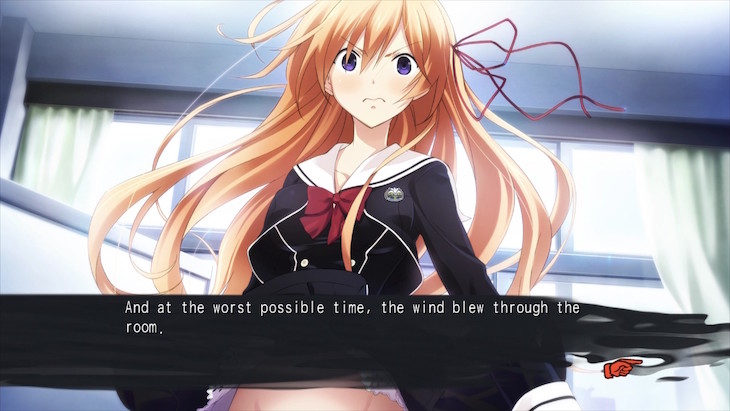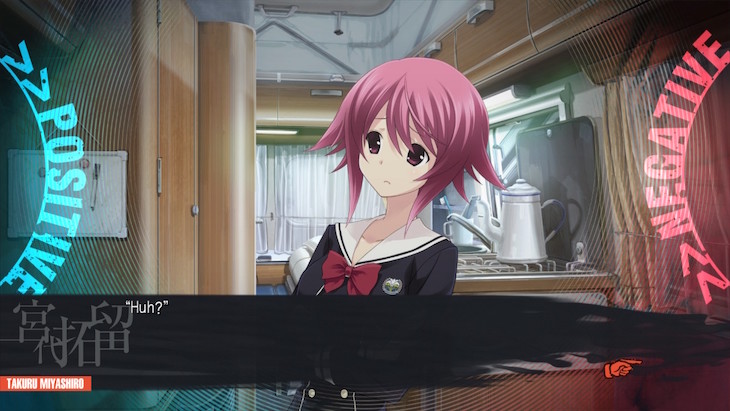
Chaos;Child is the sequel to the 2008 visual novel Chaos;Head Noah and is the fourth entry in the Science Adventure series. While it is not required to read Steins;Gate or Robotic;Notes before entering into Chaos;Child, it is highly recommended to at least play through Chaos;Head Noah, as the events that happen in the first game are discussed extensively in this title. While the themes of the first game are still present in this title, it brings about a tale that is just as eye-opening.
Much like Chaos;Head Noah, Chaos;Child does require a warning before diving in. There are just as many violent scenes (everything from murder to weird sexual scenes) as in the last game, so if you’re not up for that, this is another title to avoid. But if you were able to sit through Chaos;Head Noah, Chaos;Child doesn’t do anything that would catch you off guard.
Chaos;Child takes place six years after the initial events in Chaos;Head Noah and stars a brand new cast. The main character is Takuru Miyashiro, a high school student who is part of the newspaper club. While a bit antisocial, he has a group of friends that he regularly talks to in school. He does have his typical teenager moments where he believes he’s better than everyone, dubbing himself a “right-sider.” He is a lot more palatable than Takumi Nishijou. In fact, many of these characters feel a lot more grounded than the cast of the first game. They all come across as typical kids during your time in school.
Much like the first game, Takuru and his friends are drawn right in the center of a string of murders known as the “Return of the New Generation Madness.” Murders are starting to occur on the same days as the murders six years ago, and they are just as insane as the first batch. But as Takuru starts investigating, he finds that things aren’t quite adding up. In fact, the deeper that he digs into the cases, the more involved that he finds himself.
Overall, despite the fact that the story revolves around strange killings, this story feels a lot less fantastical. The characters and their relationships are more at the forefront and perhaps the previous knowledge of what happened in Chaos;Head Noah causes one to expect a bombshell to drop. But don’t take that to mean that there aren’t any twists or monumental shoe drops, because there are plenty for you to take in. But this title seems to fulfill the purpose of cleaning up any loose ends.
There are a total of five endings including the true route. The routes in this game actually account for a lot more of the story this time around, meaning that missing out on these endings will end up with you not even getting the full story. All four individual routes, as well as the common route also have bad endings that you can acquire as well while playing through. You’re locked into the common route your first time through, but afterwards, you can use the skip function to skip through most of the dialogue in the game. It’s recommended to consult a guide when trying to get the additional endings rather than trying to guess which delusion types to select.

Kurusu is one of the five girls whose route you can explore after finishing the game the first time.
Chaos;Child is a visual novel where you can occasionally choose to have either positive or negative delusions. These delusions act as your choices during the game, as there are no dialogue choices to make. Depending on which delusions you choose to have, you can end up on one of the many routes available in the game. Along with delusions, you’ll be expected to keep track of the details of the individual cases, as you’ll occasionally be quizzed on details concerning the locations, scenes, and individuals involved.
Chaos;Child has no dialogue choices that you can make. Instead, the only form of gameplay is primarily with delusions. Like its predecessor, you can select to have either a positive, a negative, or no delusion in order to navigate to different routes in the game. By default, you’re locked into the common route your first go round but afterwards, you can explore more of what the game has to offer. The delusion choices are a lot clearer, with new graphics that show up.

You are able to choose whether you see a positive or negative delusion. This can affect what routes you end up on.
A new interactive part of the game is during the brainstorming sessions that Takuru and his friends have in the newspaper club room. As the murders occur throughout Shibuya, the newspaper club will keep up with new developments with the cases, from locations to people of interest. While these portions don’t get too in-depth and shouldn’t catch you off guard, given that information is repeated enough times to be hammered into your memory, getting some of these sections wrong can result in a bad end.
The biggest change between Chaos;Head Noah and Chaos;Child is the artwork, which shouldn’t come as a surprise given the six year difference between the two games. The style is updated while still maintaining that connection to the series. Along with the character art, the UI has gotten a fresh coat of paint as well. However, there do appear to be visible UI issues when it comes to the text. In parts of the game, the text runs off of the screen, and some punctuation (specifically the – symbol) are edited out altogether. This can affect the readability of the game and depending on how sensitive you are to such errors, can end up taking you out of the story.
The mixture of music and sound effects to set the tone is back with Chaos;Child. The developers are aware of how to build up tension and execute it well. They also didn’t skimp on grossing out the player, with plenty of squelches and crunching noises that will send tingles down your spine as the text goes into detail on what they’re not showing you. The game may not show you all of the gruesome details, but the text picks up that slack.
The visual novel is almost completely voice acted, with the exception to the narration portions. The cast is solid, with no one character outshining the others. Every character bounces off one another well and it results in a fantastic end product.
Overall, Chaos;Child is a mixture of much of the same with a new string of strange murders, along with something new with a new cast of characters, and more questions that have cropped up. While the story doesn’t span as grand of a scale as the first game, Chaos;Child still leaves you with an outrageous plot that will leave you thinking. The upgrades concerning the art and UI of delusions makes things a lot simpler to understand.
However, there are a few hiccups that are hard to ignore. The issues with the text running off the screen appear enough to be a pattern and the strange issue with the – symbol not even appearing at all, leaving extra spaces in the text, does take away some readability. In spite of that though, this was a good follow up to Chaos;Head Child. If you can look past the text issues, Chaos;Child will deliver a story that is just as gripping as the first game.
Score: 7/10.